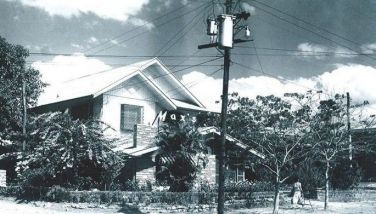Funding problem

The national government is facing a funding problem to comply with the order of the Supreme Court to increase the IRA received by LGUs.
According to the Philippine Institute for Development Studies (PIDS), the government’s economic think tank, the government may have no choice but to cut back on or “unfund” some of the programs, activities, and projects (PAPs) in the budgets of some national government agencies (NGAs).
The Supreme Court recently ruled that the source of IRA must include other national taxes such as customs duties. Based on the estimates of the Development Budget Coordinating Committee (DBCC), the IRA in 2022 is projected to increase “from P847.4 billion (if the old way of computing the IRA were followed) to P1,102.7 billion or an increment of P225.3 billion.”
The PIDS study provided three options for the government to be able to source out P1,102.7 billion for the LGUs’ IRA share in 2022.
The first option is for the government to increase tax rates or impose new taxes to generate additional government revenue equivalent to 0.9 percent of gross domestic product (GDP) in 2022 over and above incremental revenues from tax reforms intended to fund the Build Build Build program.
The second option is for the government to increase its fiscal deficit target by 0.9 percent of the GDP yearly. While this is likely to be fiscally sustainable in the short term, the PIDS study warned that implementing a more expansionary fiscal stance in the long term will be risky from a fiscal sustainability perspective.
The third is to “unfund” some PAPs that are budgeted under the General Appropriations Act (GAA) to create fiscal space for the increase in IRA. This option, according to the PIDS study, is perhaps “the most prudent from a fiscal point of view.”
The programs to be unfunded are those that are included in the budget of some NGAs, yet are assigned to LGUs under Section 17 of the Local Government Code of 1991.
With the increase of their IRA, LGUs, are expected to finance more programs and projects, which means bigger responsibilities for them. This means LGUs must upgrade their capacities to carry out more tasks and initiatives in the coming years.
Among the important functions devolved to LGUs, but still largely carried out by the national government is health, agricultural extension services, and some road/infra projects. But do the LGUs have what it takes to take on expanded responsibilities that go with increased funding?
Even now, there are complaints that LGUs outside of Metro Manila get more IRAs than they collect in taxes, yet it seems they are largely misspending the money.
Jaime Morelos, a reader of this column, thinks it is time to correct things and give Metro Manila taxpayers a break. He wrote to propose that “10 percent of the total taxes paid by the people of Metro Manila be allocated every year to build infrastructure in Metro Manila.
“I read that Metro Manila paid P1.7 trillion in income taxes last year or the other year, 10 percent of that would amount to P170 billion. That’s a lot of money year after year which should be spent to put up a mass transport system and later other infrastructures.”
Morelos was appalled to learn that Metro Manila, which contributed P1.7 trillion in taxes, only received an IRA of P32 billion for all the cities in Metro Manila. Some provinces got IRA’s 10 times or more than the total taxes which they paid.
Morelos wondered what was the basis for allocating IRA under the Local Autonomy Law at 40 percent of all taxes collected. Was NEDA or DOF consulted?
The government does not have big projects in Metro Manila, Morelos lamented, as all the big infrastructure projects in the Metro are undertaken by private companies, and residents pay to use those services.
Come to think of it, how come none of the congressmen representing Metro Manila districts complained about the unfair IRA allocation?
The large IRAs of LGUs outside NCR could have been justified if it had resulted in visible development of the countryside. Morelos cited the case of Nueva Ecija.
“The IRA of Nueva Ecija in 2018 is P11 billion and since 1992 the IRA of Nueva Ecija from 1992 to the present must be between P150 billion to P200 billion. Yet, Nueva Ecija was left behind by its neighbors. Part of the IRA was probably spent for basketball courts, which is usually the favorite expenditures of local officials, where the other billions went is as usual a mystery.”
In the article “Rich provinces, poor provinces” in the Inquirer in June 2018, former World Bank economist Rolando T. Dy, currently executive director of the Center for Food and Agri Business of the University of Asia and the Pacific, wrote that some provinces’ poverty rates are difficult to explain if viewed alongside their neighbors.
In Central Luzon, he wrote, “what is baffling is the high poverty of Nueva Ecija (22.6 percent), which borders Pampanga (4.9 percent) and Bulacan (4.5 percent).”
This, despite Nueva Ecija being considered as the Philippines’ rice granary and “a high rice yielder,” Dy wrote. We can only surmise the reason is poor LGU leadership that has resulted in among others, wasting its IRA.
Nevertheless, even metro LGUs should use their IRAs more productively.
Makati, for example, was able to use its IRA for very visible and useful projects for their constituents.
They have well-provided public schools up to the university level. They have a hospital and good universal health care… better than PhilHealth.
The good news is… the LGUs in NCR are starting to wake up. All the cities of Metro Manila will import 10 million doses of the AstraZeneca vaccine. This will be a good use of their increased IRA and the national government can remove that need from the national budget.
The point of Mr.. Morelos is simply this: Metro Manila taxpayers must get a fair share of the benefits from the taxes they pay. That’s basic.
Boo Chanco’s e-mail address is bchanco@gmaill.com Follow him on Twitter @boochanco
- Latest
- Trending


























